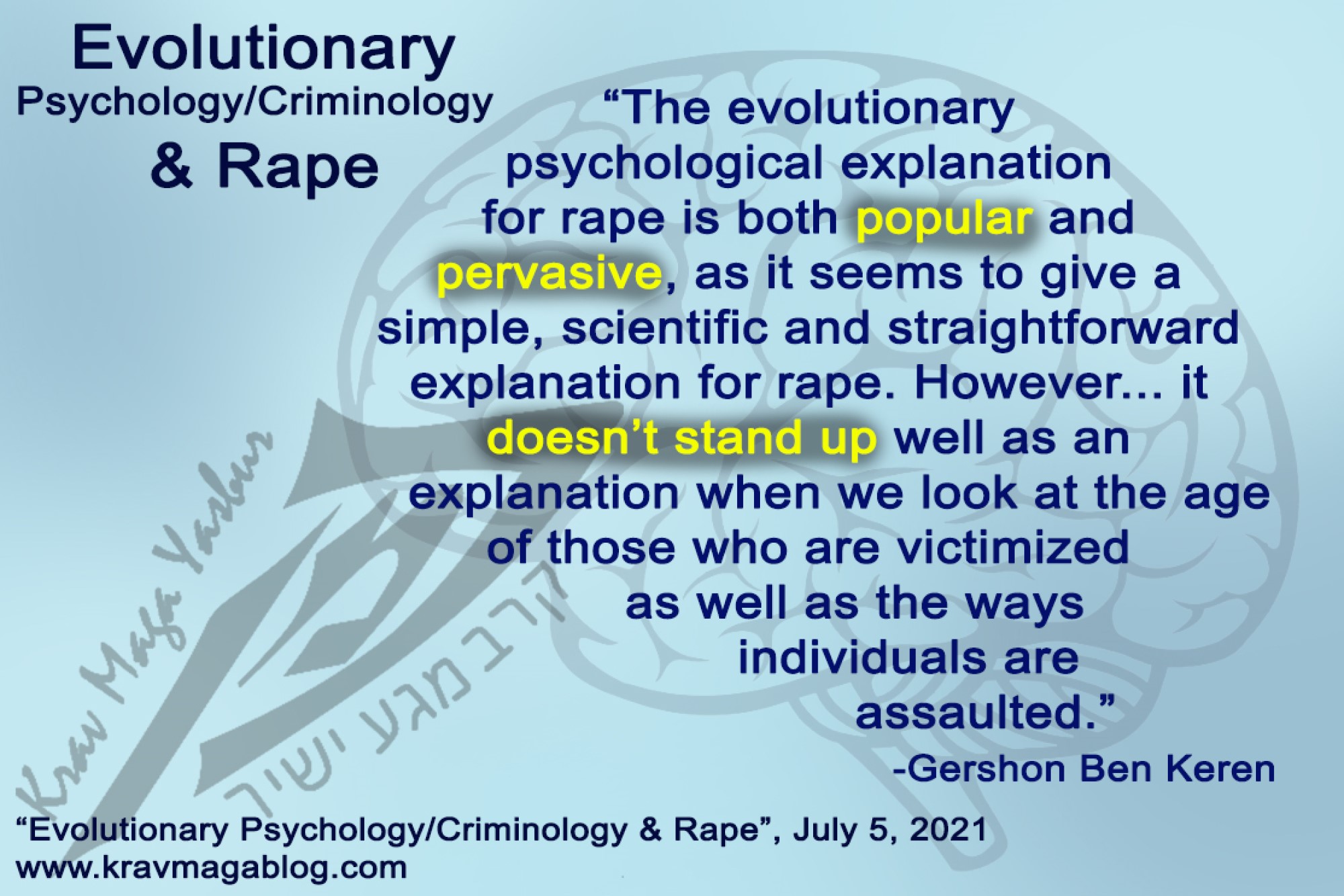Author: Gershon Ben Keren

Evolutionary psychology looks to explain universal human behaviors from the perspective of evolutionary adaptation, whilst evolutionary criminology looks to do the same concerning offending. However, it should be noted that crime is a socially constructed concept, and is often subject to change and redefinition e.g., Marijuana is now legal in US States where its use was once prohibited, and where sentencing was extremely harsh etc. This presents an issue/problem for anyone trying to make a claim that genetics and biology are solely responsible for offending behavior(s). Whilst genetics can influence an individual’s character, it would be extremely difficult to tie genes to specific types of offending etc. One area where evolutionary psychology/criminology has gained a lot of traction is in its argument that rape gives animals and individuals an evolutionary advantage in reproduction. In this article I want to discuss why this idea/view is both scientifically wrong (it has been largely rejected by the scientific community) and dangerous e.g., it makes rape and sexual assault inevitable, and gives those who commit such acts a biological/psychological excuse, that they were driven by evolutionary urges that they were unable to control etc.
There is something that is referred to as the “Naturalistic Fallacy”. This is where certain animal behaviors that are shared by humans, are used to explain the reasons behind why humans act/behave in a certain way e.g., because certain species of monkeys such as Mantled Howler Monkeys will engage in forced/coercive mating as a part of “sperm competition”, human rape must therefore be driven by a similar “evolutionary” urge to reproduce, even if sexual assailants and rapists aren’t consciously aware of this. However, human beings are not monkeys, but are instead a highly individualized species that whilst sharing certain practices with other mammals, are also quite different and unique e.g., we lack the complex greeting rituals of other social animals such as elephants, as well as the rituals that wolves and dogs use to avoid violence, and unlike these animals are capable of great feats of engineering and creativity etc. Therefore, it would be incorrect to look at the way animals use/engage in coerced and forced sex, and deduce that this mirrors our own behaviors e.g., certain monkey species will see a new group/troop leader publicly rape all the female members after deposing the old alpha male as a show of social dominance, whilst most human acts of rape are private or semi-private affairs and are not committed to demonstrate social standing(s) to a particular audience etc. Such examples also show that animals use sex for reasons other than procreation, like Bonobos (pygmy chimps) who use it as a means of reconciliation after disputes and conflicts, and so to look at sex – both consensual and non-consensual - from a purely reproductive perspective is extremely narrow and simplistic.
To look at the way Mallard Ducks use rape to increase their reproductive chances and make the argument that human rape is motivated by this fundamentally overlooks the facts concerning human rape. If we look at the statistics for rape by age, roughly a third of women victimized are below prepubescent age i.e., they are incapable of conceiving, and post-menopausal women are also victimized. The “evolutionary” argument that rape is an evolutionary tool to increase the chances of reproduction fails to explain such assaults. Sexual assaults which do not involve vaginal penetration cannot be explained using this evolutionary explanation, nor those where the assailant wears a condom to decrease the risks of detection – something which is more common in serial rapists, and which Chopin et al. (2019) believe to be a “forensic awareness” that occurs in around 10-15% of such assaults. The theory also doesn’t explain gang rapes, which increase “sperm competition”. It is estimated (Beck et al., 2019) that roughly 5% of women who are victims of rape become pregnant, suggesting that as a reproductive strategy rape is not particularly successful. In other species where there are distinct mating seasons, when animals know that the chance of conception is high at a particular time, rape may be a viable and successful reproductive strategy, but in humans this is not the case, and it would be wrong to try and draw a parallel. This has not stopped some evolutionary psychologists and criminologists to engage in statistical gymnastics – usually trying to take into “account” the potential effects of birth control in sexual assaults – suggesting that conception rates in rapes are much higher than those involving consensual sex.
The evolutionary psychological explanation for rape is both popular and pervasive, as it seems to give a simple, scientific and straightforward explanation for rape. However, as has hopefully been presented it doesn’t stand up well as an explanation when we look at the age of those who are victimized as well as the ways individuals are assaulted. It is also a viewpoint which suggests the full responsibility for reducing the number of rapes and sexual assaults, rests wholly with women, as it would be futile to try and fight against male biology and evolution. Whilst it would be dangerous to make the argument that rape and sexual assaults are fully sociological creations, the role that society plays in the way that women and sexual relationships are presented does influence male psychological development during childhood and adolescence and has the potential to lead to dark fantasies and distorted thought processes. Therefore, rather than seeing the underlying motivation(s) behind rape and sexual assaults as being hard-wired and unchangeable we should take a more optimistic position and look at the conditions which facilitate healthy psychological development.